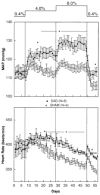A sympathetic view of the sympathetic nervous system and human blood pressure regulation
- PMID: 18326553
- PMCID: PMC3433836
- DOI: 10.1113/expphysiol.2007.039545
A sympathetic view of the sympathetic nervous system and human blood pressure regulation
Abstract
New ideas about the relative importance of the autonomic nervous system (and especially its sympathetic arm) in long-term blood pressure regulation are emerging. It is well known that mean arterial blood pressure is normally regulated in a fairly narrow range at rest and that blood pressure is also able to rise and fall 'appropriately' to meet the demands of various forms of mental, emotional and physical stress. By contrast, blood pressure varies widely when the autonomic nervous system is absent or when key mechanisms that govern it are destroyed. However, 24 h mean arterial pressure is still surprisingly normal under these conditions. Thus, the dominant idea has been that the kidney is the main long-term regulator of blood pressure and the autonomic nervous system is important in short-term regulation. However, this 'renocentric' scheme can be challenged by observations in humans showing that there is a high degree of individual variability in elements of the autonomic nervous system. Along these lines, the level of sympathetic outflow, the adrenergic responsiveness of blood vessels and individual haemodynamic patterns appear to exist in a complex, but appropriate, balance in normotension. Furthermore, evidence from animals and humans has now clearly shown that the sympathetic nervous system can play an important role in longer term blood pressure regulation in both normotension and hypertension. Finally, humans with high baseline sympathetic traffic might be at increased risk for hypertension if the 'balance' among factors deteriorates or is lost. In this context, the goal of this review is to encourage a comprehensive rethinking of the complexities related to long-term blood pressure regulation in humans and promote finer appreciation of physiological relationships among the autonomic nervous system, vascular function, ageing, metabolism and blood pressure.
Figures







References
-
- Alvarez GE, Beske SD, Ballard TP, Davy KP. Sympathetic neural activation in visceral obesity. Circulation. 2002;106:2533–2536. - PubMed
-
- Anderson EA, Sinkey CA, Lawton WJ, Mark AL. Elevated sympathetic nerve activity in borderline hypertensive humans. Evidence from direct intraneural recordings. Hypertension. 1998;14:177–183. - PubMed
-
- Angell-James J. Michael de Burgh Daly obituary. Physiology News. 2003;50:39–40.
-
- Bell C, Seals DR, Monroe MB, Day DS, Shapiro LF, Johnson DG, Jones PP. Tonic sympathetic support of metabolic rate is attenuated with age, sedentary lifestyle, and female sex in healthy adults. J Clin Endocrinol Metab. 2001;86:4440–4444. - PubMed
-
- Charkoudian N, Joyner MJ, Barnes S, Johnson CP, Eisenach JH, Dietz NM, Wallin BG. Relationship between muscle sympathetic nerve activity and systemic hemodynamics during nitric oxide synthase inhibition in humans. Am J Physiol Heart Circ Physiol. 2006a;291:H1378–H1383. - PubMed
Publication types
MeSH terms
Grants and funding
LinkOut - more resources
Full Text Sources

